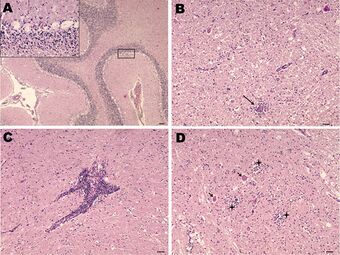Medicine:Louping ill
| Louping ill | |
|---|---|
| Other names | Ovine encephalomyelitis, infectious encephalomyelitis of sheep, trembling-ill |
 | |
| Nonsuppurative encephalitis in goat affected by louping ill. A) Cerebellum with necrosis of Purkinje cells. Hematoxylin and eosin (H&E) stain; scale bar = 100 µm. Inset: necrosis of Purkinje cells. H&E stain; scale bar = 20 µm. B) Midbrain. Area of neurophagia (arrow) surrounded by microglial cells. Necrosis of neurons can be also seen. H&E stain; scale bar = 50 µm. C) Lymphoid perivascular cuff in midbrain. H&E stain; scale bar = 50 µm. D) Spinal cord, gray matter. Focal microgliosis (crosses) and neurons undergoing necrosis (arrows). H&E stain; scale bar = 50 µm. | |
| Specialty | Veterinary medicine |
Louping-ill (/ˈlaʊpɪŋɪl/) is an acute viral disease primarily of sheep that is characterized by a biphasic fever, depression, ataxia, muscular incoordination, tremors, posterior paralysis, coma, and death. Louping-ill is a tick-transmitted disease whose occurrence is closely related to the distribution of the primary vector, the sheep tick Ixodes ricinus. It also causes disease in red grouse, and can affect humans. The name 'louping-ill' is derived from an old Scottish word describing the effect of the disease in sheep whereby they 'loup' or spring into the air.[1]
Cause
| Louping ill virus | |
|---|---|
| Virus classification | |
| (unranked): | Virus |
| Realm: | Riboviria |
| Kingdom: | Orthornavirae |
| Phylum: | Kitrinoviricota |
| Class: | Flasuviricetes |
| Order: | Amarillovirales |
| Family: | Flaviviridae |
| Genus: | Flavivirus |
| Species: | Louping ill virus
|
Louping ill is caused by RNA virus called Louping ill virus. Louping ill virus belongs to genus Flavivirus,[2] family Flaviviridae.
There are four subtypes: British, Irish, Spanish and Turkish.[citation needed]
Prevention
According to a ProMED article,[3] disease in sheep has been controlled in the UK by a vaccine (ATCvet code: QI04AA01), originally developed by Scotland's Moredun Research Institute by Prof John Russell Greig.[4] In 2009, however, a shortage of vaccine combined with an increase in the number of ticks found in sheep pasture areas cause an increased risk of this disease.[citation needed]
References
- ↑ Health Protection Agency. Louping ill. Background information. Last reviewed: 8 August 2008. Last viewed 23 April 2009.
- ↑ "Tick-borne virus diseases of human interest in Europe", Clin. Microbiol. Infect. 10 (12): 1040–55, December 2004, doi:10.1111/j.1469-0691.2004.01022.x, PMID 15606630.
- ↑ "ProMED Archive Number 20090420.1492, Published Date 20-APR-2009, Subject PRO/AH> Louping ill - UK: vaccination". http://www.promedmail.org/pls/otn/f?p=2400:1001:::NO::F2400_P1001_BACK_PAGE,F2400_P1001_PUB_MAIL_ID:1000%2C77119.
- ↑ "Archived copy". Archived from the original on 2016-08-21. https://web.archive.org/web/20160821154717/http://www.moredun.org.uk/webfm_send/579. Retrieved 2016-08-04.
- Committee on Foreign Animal Diseases of the United States Animal Health Association (1998), Foreign Animal Diseases, Pat Campbell & Assoc/Carter Printing Co., ISBN 0-08-615213-0, archived from the original on 2009-02-13, https://web.archive.org/web/20090213234455/http://www.vet.uga.edu/vpp/gray_book02/fad/loi.php
- Louping ill, Center for Food Security and Public Health, College of Veterinary Medicine, Iowa State University, 2005-08-05, http://www.cfsph.iastate.edu/Factsheets/pdfs/louping_ill.pdf
External links
| Classification |
|---|
- Moredun Research Institute vaccine article
- WHO vaccine listing: QI04AA01 (WHO))
Wikidata ☰ {{{from}}} entry

